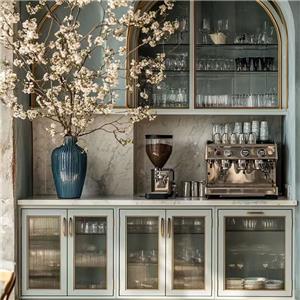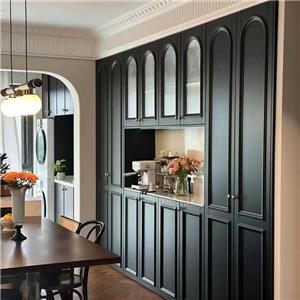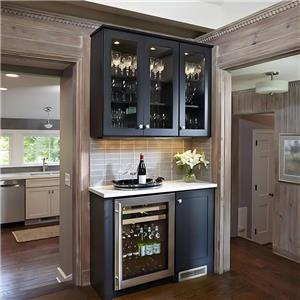What is the difference between European cabinets and traditional cabinets?
Kitchen cabinets are not only important functional furniture in the home, but also one of the core of home design style. With the deepening of globalization, kitchen cabinet designs under different cultural backgrounds have gradually blended and influenced modern family life. Among them, European kitchen cabinets and traditional kitchen cabinets are the two mainstream styles, each with its own unique design concept, material selection and craftsmanship characteristics.
So, what is the difference between European kitchen cabinets and traditional kitchen cabinets? This article will explore the differences between these two kitchen cabinet styles in depth, analyze them from multiple aspects such as design style, craft materials, functionality and use experience, and provide consumers with a comprehensive understanding.
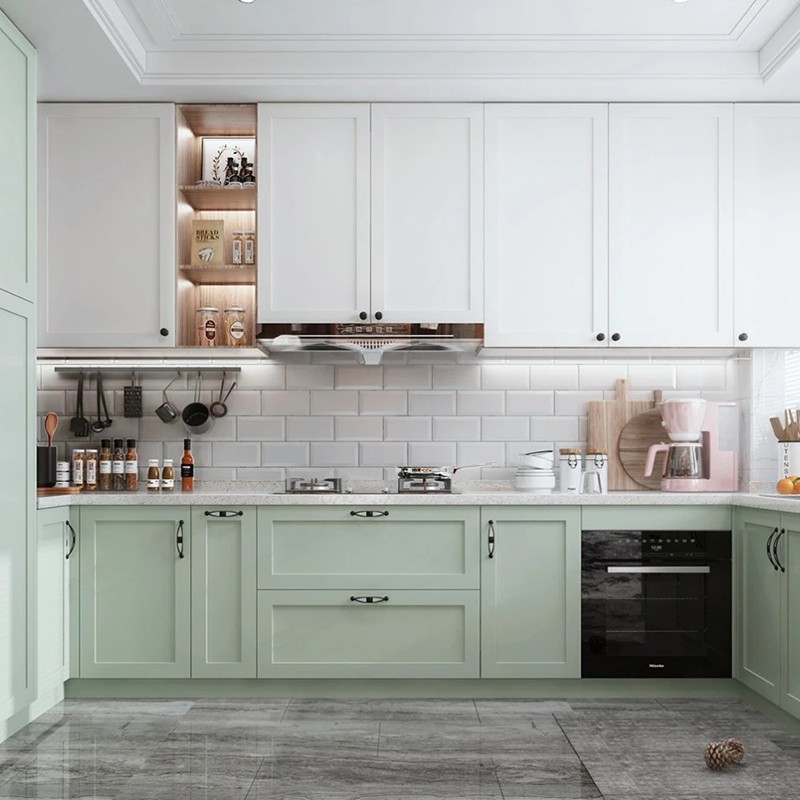
What is European kitchen cabinet?
First of all, it should be clear that European kitchen cabinets usually refer to kitchen design styles originating from European countries, including design features of countries such as Italy, France, and Germany. They usually pay attention to exquisite details, symmetrical lines and elegant decorative styles. Whether it is classical or modern European style, it will give people a noble and luxurious visual experience.
What is a traditional kitchen cabinet?
In contrast, traditional kitchen cabinets are more extensive, generally referring to the kitchen cabinet style that has been used for a long time under different cultural backgrounds. In China, the United States and some other countries, traditional kitchen cabinet design is centered on practicality, while also incorporating local historical and cultural characteristics. Traditional kitchen cabinets usually emphasize the natural beauty and stability of wood materials, with solid wood as the main material, and the design is simple and heavy.
What is the difference between European kitchen cabinets and traditional kitchen cabinets?
European kitchen cabinets and traditional kitchen cabinets: Differences in design styles
1. European kitchen cabinets: luxury and elegance coexist
The design style of European kitchen cabinets is often obviously decorative and artistic. In particular, classical European kitchen cabinets, influenced by the architectural and furniture design styles of the European Renaissance, show a high emphasis on decorative elements such as carvings, inlays and reliefs. For example, a typical French kitchen cabinet has curved lines, exquisite carvings and complex border designs, while Italian-style kitchen cabinets tend to have a simple structure, but still show low-key luxury through details such as marble countertops and copper handles.
European kitchen cabinets are very particular about symmetry and balance. Whether it is the design of the cabinet door or the layout of the entire kitchen, designers will pay attention to the visual sense of coordination. For example, the color and material matching between the kitchen cabinets and the walls, countertops, and floors have been carefully designed to ensure that the space has a high aesthetic value.
2. Traditional kitchen cabinets: practical and calm beauty
In contrast, the design of traditional cabinets often pays more attention to practicality. Especially in traditional American kitchen cabinets, the design style is often dominated by functionality, emphasizing spacious storage space and sturdy and durable structure. The lines of traditional kitchen cabinets are relatively simple, with few surface decorations, but they are mostly made of natural wood, presenting a simple and stable style.
The design of traditional Chinese kitchen cabinets combines the Chinese classical style. You can often see fine carvings and unique mortise and tenon structures. The functionality and aesthetic value of the kitchen cabinets coexist. In terms of color, traditional kitchen cabinets often use more calm tones, such as dark brown, walnut, etc., giving people a heavy and warm feeling.
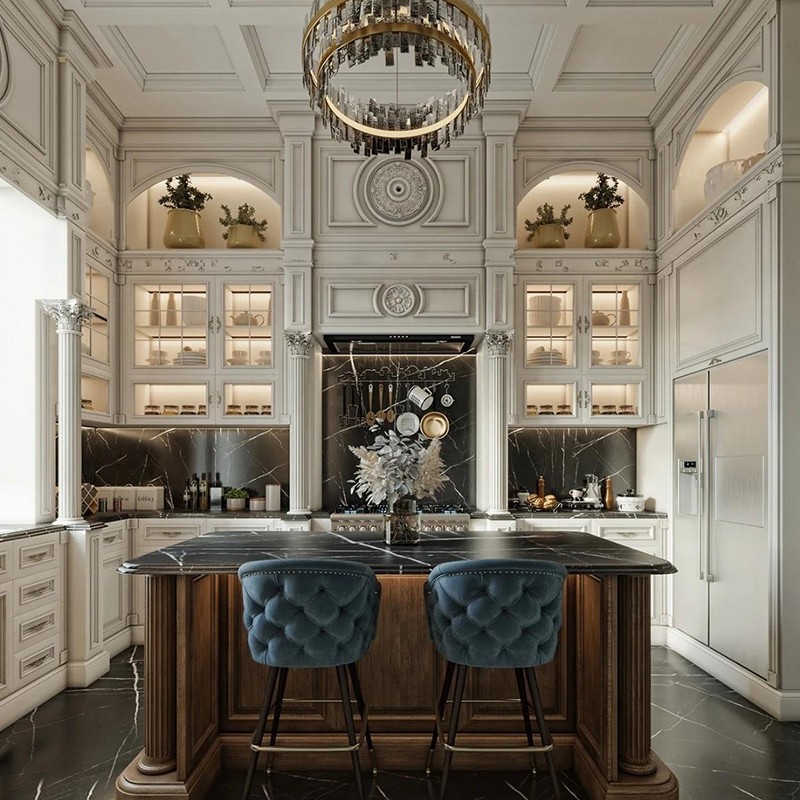
European kitchen cabinets and traditional kitchen cabinets: the difference between craftsmanship and materials
1. High-end material selection for European kitchen cabinets
The design of European kitchen cabinets not only gives people a sense of luxury visually, but also pays great attention to the selection of materials. Common materials include high-grade woods such as oak, walnut, and cherry. In addition, marble and stainless steel are also widely used in the countertops and decorative parts of European kitchen cabinets.
In addition to wood and stone, the hardware accessories of European kitchen cabinets are mostly imported high-end products. For example, the handles and hinges of kitchen cabinets are often made of copper or aluminum alloy, and are finely carved or polished. These details not only enhance the overall texture of the kitchen cabinet, but also make the use experience smoother.
2. Solid wood and durable materials of traditional kitchen cabinets
Traditional kitchen cabinets, especially American-style kitchen cabinets, use more solid wood as the main material, usually cherry, oak or pine. These woods are not only strong and durable, but also have natural texture beauty. As time goes by, the wood will gradually show a more mellow color, which is also the charm of traditional kitchen cabinets.
The production process of traditional kitchen cabinets is relatively simple, emphasizing stability and durability. For example, the traditional Chinese mortise and tenon structure can firmly connect the various parts of the kitchen cabinet without nails. This structure is durable and shows the superb skills of traditional craftsmanship. Compared with European kitchen cabinets, traditional kitchen cabinets use fewer hardware accessories and are more practical, emphasizing long-term durability rather than luxurious appearance.
European kitchen cabinets and traditional cabinets: Differences in kitchen cabinet functionality and space utilization
1. Intelligent and multifunctional design of European kitchen cabinets
With the development of technology, modern European kitchen cabinets are becoming more and more intelligent and multifunctional in functional design. Many high-end European kitchen cabinet brands will integrate automatic door opening and closing systems, hidden appliances, smart storage space and other designs into kitchen cabinets, further improving the convenience of kitchen use. For example, a drawer may be equipped with an intelligent lighting system, and the light will automatically light up when you open the drawer; some kitchen cabinets are also equipped with an electric switch function, which can be turned on with a light press, making the operation more convenient.
At the same time, European kitchen cabinet design often pays attention to the diversified design of details. Every space in the kitchen is fully utilized, such as hidden trash cans and lifting storage racks, which can greatly improve the functionality of the kitchen.
2. The practicality and large capacity of traditional kitchen cabinets
The design of traditional kitchen cabinets focuses more on the optimization of storage space. Large capacity is one of the hallmarks of traditional kitchen cabinets, especially in American kitchens, where kitchen cabinets are usually designed to be large to accommodate various kitchen utensils and ingredients. Although they are not as technologically advanced as European kitchen cabinets, their stability and practicality are impeccable.
Traditional kitchen cabinets also often adopt an open design, allowing users to access items more conveniently. Many traditional Chinese kitchen cabinets also incorporate mortise and tenon structures, allowing the internal space of the kitchen cabinet to be flexibly combined and adjusted, further enhancing practicality.
European kitchen cabinets and traditional kitchen cabinets: the use of decoration and color
1. The diverse colors and detailed decoration of European kitchen cabinets
The use of European kitchen cabinets is rich and diverse. You can choose classic light tones such as white and ivory, or boldly try dark colors such as dark blue, dark green, and even black to create a modern and fashionable atmosphere. The choice of color often echoes the overall decoration style and can create a variety of different visual effects.
In terms of decoration, European kitchen cabinets usually incorporate complex carving details, especially in the design of cabinet doors and cabinet feet, where exquisite patterns and carvings can often be seen. These decorations not only improve the beauty of the kitchen cabinets, but also enhance the overall style and atmosphere of the kitchen.
2. The calm tones and simple decoration of traditional kitchen cabinets
Traditional kitchen cabinets are relatively conservative in the choice of colors, usually dominated by calm tones such as brown, walnut, and dark red. These colors not only show the natural texture of wood, but also convey a heavy and warm atmosphere.
In terms of decoration, traditional kitchen cabinets are often simple, especially American-style kitchen cabinets. The design of the cabinet door is mostly flat or simple frame structure, with almost no extra carving and decoration. This design is more in line with the traditional family's pursuit of practicality, and visually gives people a clean and clear impression.
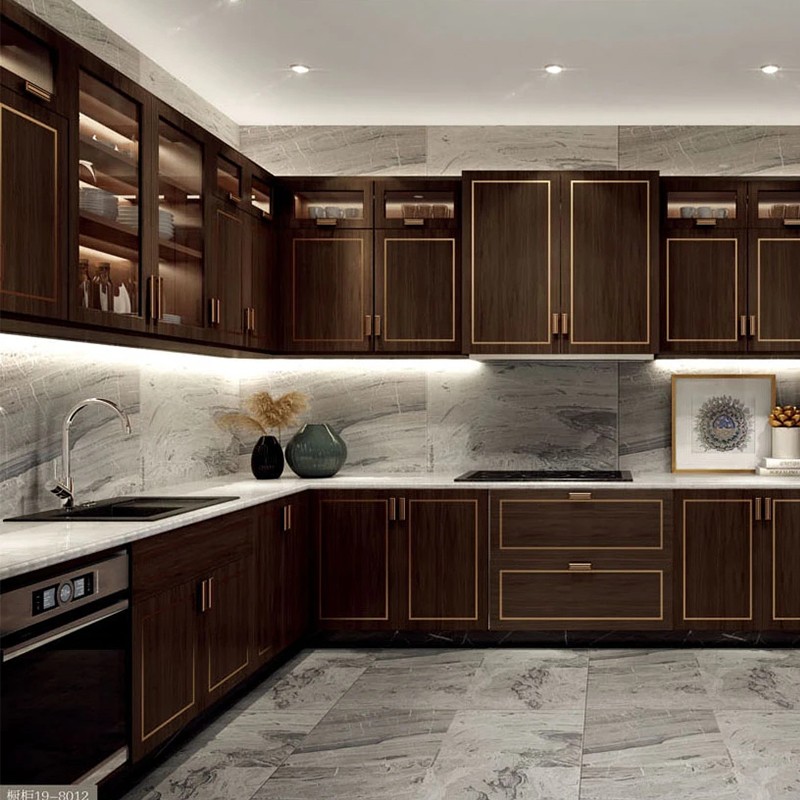
European kitchen cabinets and traditional kitchen cabinets: the difference in price and grade
1. The high-end positioning of European kitchen cabinets
Due to the high requirements of European kitchen cabinets in material selection, craftsmanship and design, their prices are usually higher. In particular, some customized European kitchen cabinets often need to be planned and handmade by professional designers, with a long construction period and relatively high costs. In addition, the hardware accessories and countertop materials of European kitchen cabinets are also imported high-end products, so the overall price is not cheap.
2. The cost-effectiveness advantage of traditional kitchen cabinets
In contrast, although traditional kitchen cabinets use high-quality materials such as solid wood, they are relatively affordable due to their relatively simple craftsmanship and low production costs. In particular, some traditional kitchen cabinets of popular brands often have a high cost-effectiveness and are suitable for families with limited budgets but pursuing durability.
How to choose a kitchen cabinet that suits you?
In summary, European kitchen cabinets and traditional kitchen cabinets have significant differences in design style, material selection, functionality and price positioning. European kitchen cabinets are suitable for consumers who pursue high-end quality and fashionable design, while traditional kitchen cabinets are more suitable for families who focus on practicality and durability. When choosing kitchen cabinets, consumers can make the best choice based on personal preferences, home style and budget. Whether it is the elegant luxury of European style or the calm and heavy traditional style, it can add unique charm to your kitchen.

